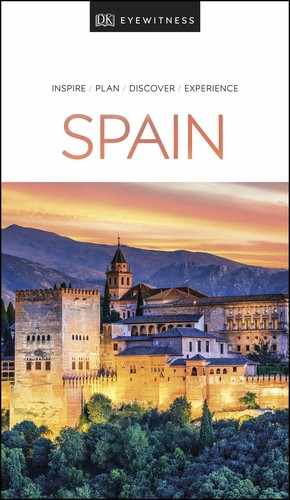Experience More

t The waterfront promenade in Playa Blanca, popular for an early evening stroll
The fishing village origins of this resort are readily apparent around its harbour. Although it has expanded in recent years, Playa Blanca remains a family-oriented place with character. It has plenty of cafés and restaurants, shops and bars, and several large hotels. There are one or two good stretches of sand near to the town, but the most enticing lie around the rocky headlands to the east, where the clear sea laps into rocky coves, and clothes seem superfluous. Playa de Papagayo is the best known of these, but a diligent search will gain you one all to yourself. A four-wheel-drive vehicle is advisable to negotiate the unsurfaced roads that lead to these beaches.
The underwater Museo Atlántico combines art and conservation. Jason deCaires Taylor’s installations act as an artificial reef for banks of sardines and octopuses.
"
Museo Atlántico
⌂ Puerto Marina Rubicón, Calle el Berrugo 2 # 10am–5pm Mon–Fri (diving: to 4pm) ∑ cactlanzarote.com
More than 60 per cent of Lanzarote’s tourists stay in this resort, which stretches several kilometres along the seafront. The coastal road carves its way through holiday infrastructure, which is pleasantly designed and unoppressive, and offers easy access to a long golden beach, Playa Blanca. Another beach nearby is Playa de los Pocillos. To the north is the quaint village of Tías and A Casa José Saramago, the house-cum-museum where the Nobel Prize-winning writer (1922–2010) lived his last 18 years in exile after the Portuguese government deemed his work to be religiously offensive.
From 1730 to 1736, a series of volcanic eruptions took place on Lanzarote, burying over 200 sq km (77 sq miles) of Lanzarote’s most fertile land in lava. Miraculously, no one was killed, though many islanders emigrated.
Today, the volcanoes that once devastated Lanzarote provide an enigmatic attraction, aptly known as the Montañas del Fuego (Fire Mountains). They are part of the Parque Nacional de Timanfaya, established in 1974 to protect a fascinating and important geological record. The entrance to the park lies north of the village of Yaiza, where you can enjoy wonderful views across the park. Afterwards, you drive through haunting scenery of dark, barren lava cinders topped by brooding red-black volcano cones. Finally, you will reach Islote de Hilario, where you can park at El Diablo panoramic restaurant. From here, buses take visitors for 30-minute tours of the desolate, lunar-like landscapes.
Afterwards, back at Islote de Hilario, guides will provide graphic demonstrations that this volcano is not extinct, but only dormant – brushwood pushed into a crevice bursts instantly into a ball of flame, while water poured into a sunken pipe shoots out in a scorching jet of steam.
EXPERIENCE Eastern Canary Islands
|
Eat La Carmencita del Puerto This Puerto del Carmen tapas bar is about as authentically Spanish as they come. ⌂ Avenida de Las Playas s/n, Puerto del Carmen, Lanzarote ∑ lacarmencitadelpuerto.com ¡¡¡ |
The contrast between old town Teguise, Lanzarote’s former capital, and the exclusive Costa Teguise is striking. Amid the arid, low-lying terrain of this barren ashland, fake greenery and suburban lamps line boulevards filled with time-share accommodation, leisure clubs and luxury hotels.
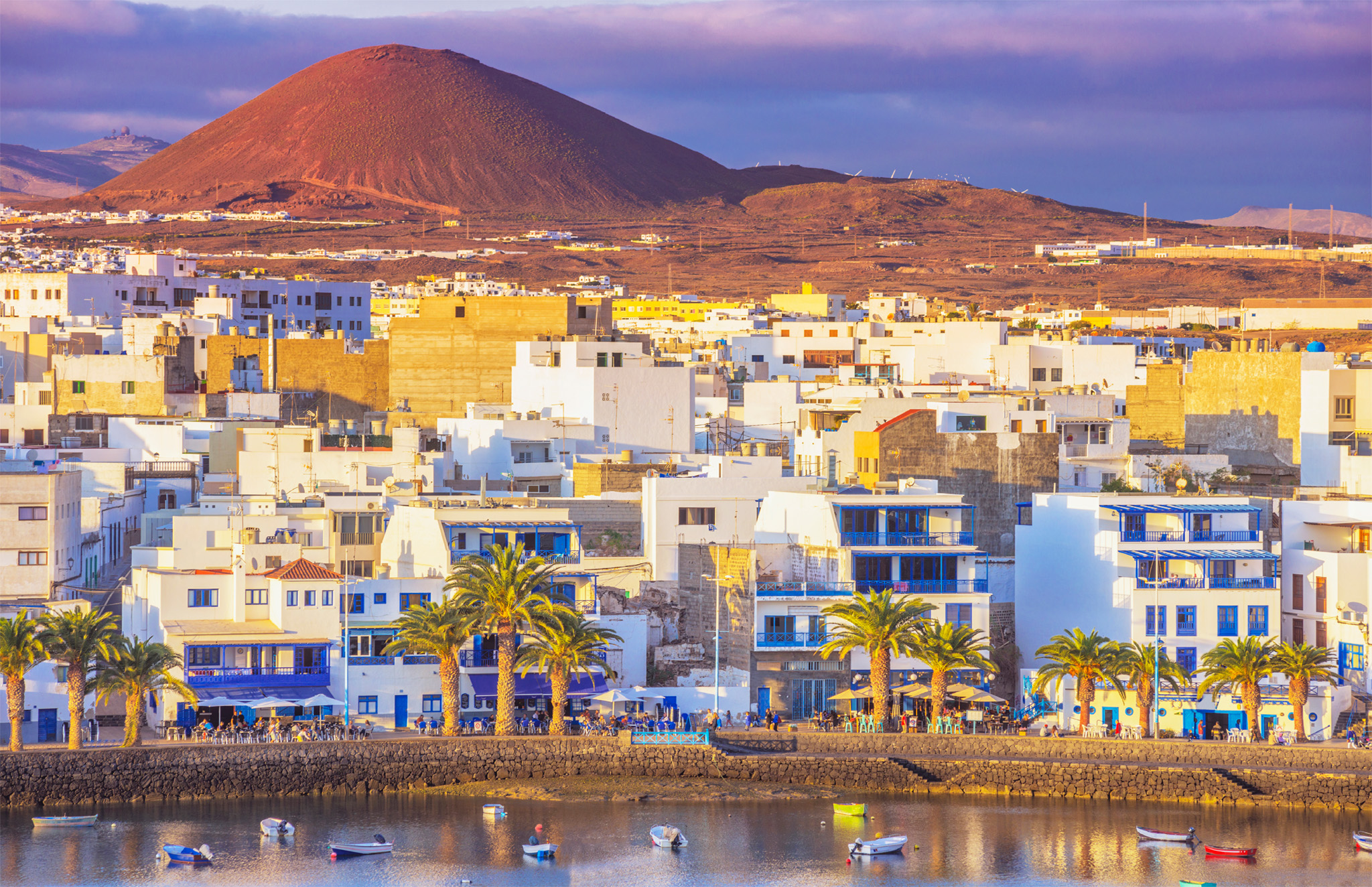
t Fishing boats on the water in front of the charming town of Arrecife
Arrecife, with its modern buildings and lively streets, is the commercial and administrative centre of the island. Despite its modern trappings, the capital retains much of its old charm, with palm-lined promenades, a fine beach and two small forts. Castillo San Gabriel offers lovely views from a mezzanine, accessed via a stone walkway over the sea. It also houses the Museo de Historia de Arrecife. The 18th-century Castillo de San José is now a museum of contemporary art and was renovated by César Manrique. One of his paintings is on display here.
Castillo San Gabriel
⌂ Calle Punta de la Largarta § 928 80 28 84 # 9am–5pm Mon–Fri, 10am–2pm Sat ¢ Public hols
Castillo de San José
⌂ Puerto de Naos § 928 81 23 21 # 10am–8pm daily ¢ 1 Jan, 25 Dec
César Manrique
Lanzarote hero César Manrique trained as a painter, and spent time in mainland Spain and New York before coming back to his island home for good in 1968. The artist, sculptor and architect campaigned for traditional and environmentally friendly development on the island, setting strict building height limits and colour requirements. Many tourist sites throughout the Canaries benefited from his talents.
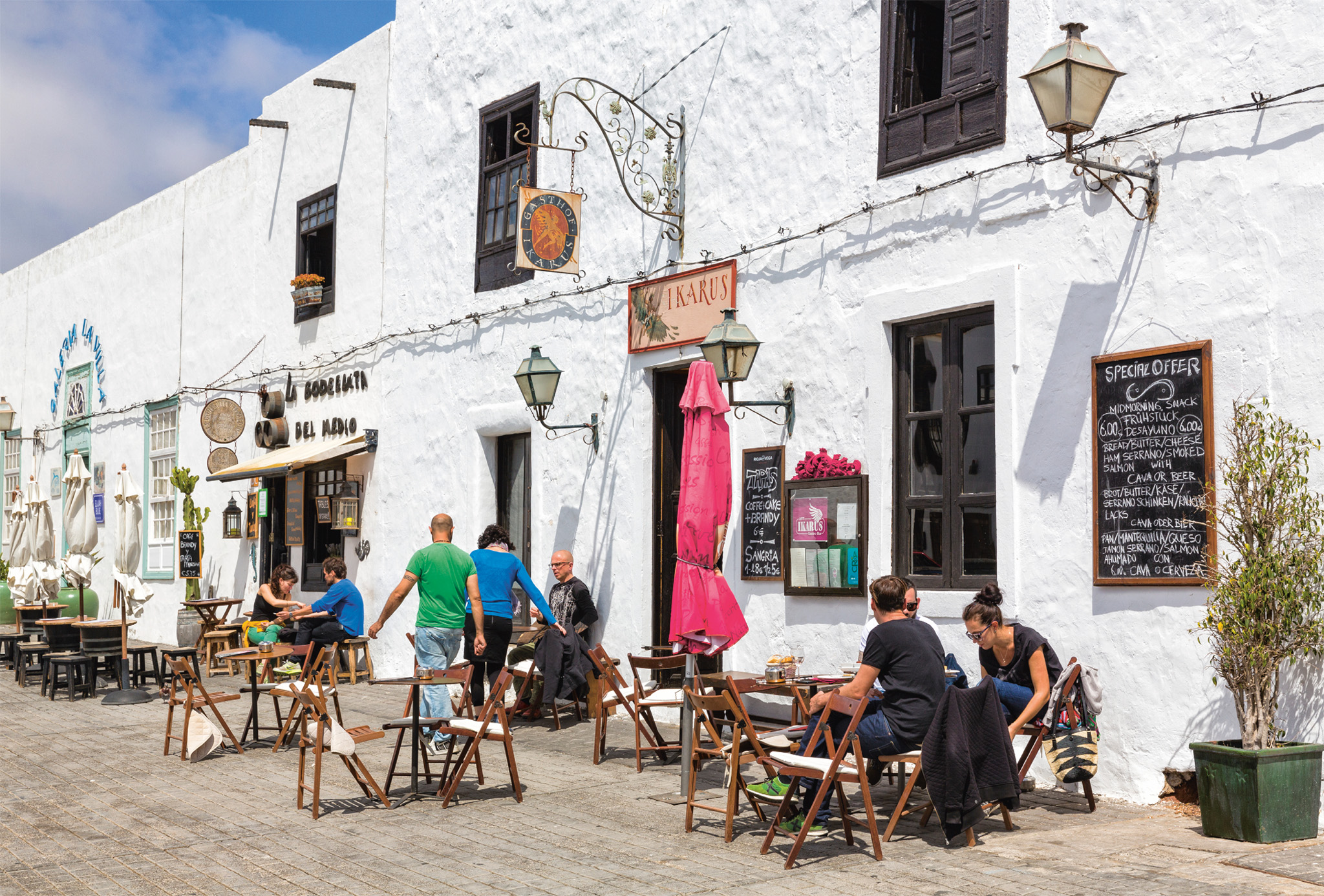
t Shops and restaurants set up outside traditional white houses in Teguise
The island’s capital until 1852, Teguise is a well-kept, old-fashioned town with wide, cobbled streets. Visit on a Sunday, when there is a handicrafts market and folk dancing.
Outside Teguise, in the 15th-century castle of Santa Bárbara, is the Museo de la Piratería, which tells the story of the pirates who passed through this area. From here there are fine views of the town, as well as a large part of the island.
If you want to see more of inland Lanzarote, follow the central road south of Teguise, through the strange farmland of La Geria. Black volcanic ash covering the landscape has been scooped into protective, crescent-shaped pits which trap moisture to enable vines and other crops to flourish. Mozaga, one of the main villages in the area, is a major centre of wine production. Standing on the roadside near Mozaga is the Monumento al Campesino, César Manrique’s striking modern sculpture that is dedicated to Lanzarote’s farmers.
Located between Teguise and Arrecife is the Fundación César Manrique. The former home and studio of the artist is a work of art itself. It incorporates five lava caves, some of his own work and his contemporary art collection.
"
Museo de la Piratería
⌂ Montaña de Guanapay # 10am–4pm daily ¢ 1 & 6 Jan, 25 Dec ∑ museodelapirateria.com
"
Fundación César Manrique
⌂ Taro de Tahíche # 10:30am–6pm daily ¢ 1 Jan ∑ fcmanrique.org
Palm trees and white, cube-shaped houses distinguish this picturesque village. It acts as a gateway to excursions round the northern tip of the island. The road to the north gives memorable views over exposed cliffs and the 609-m- (2,000-ft-) high Monte Corona.
From Manrique’s Mirador del Río you get excellent views of La Graciosa, and the northernmost of the Canary Islands, Alegranza. To the south are the Mala prickly pear plantations, where cochineal (crimson dye) is extracted from the insects which feed on the plants. Nearby is the Jardín de Cactus, a cactus garden with around 450 species of cactus, again designed by Manrique. The vivid green shade of the plants stands out against the blue sky and dark volcano.
"
Mirador del Río
⌂ Haría § 928 52 65 48 # Mid-Jul–mid-Sep: 10am–6:45pm daily; mid-Sep–mid-Jul: 10am–5:45pm daily
"
Jardín de Cactus
⌂ Guatiza § 928 52 93 97 # 10am–5:45pm daily
An eruption of the Monte Corona volcano formed the Jameos del Agua lava caves on Lanzarote’s northeast coast. Between 1965 and 1968, these caves were landscaped by César Manrique into an imaginative subterranean complex containing a restaurant, nightclub, a swimming pool edged by palm trees, and gardens of oleander and cacti. Steps lead to a shallow seawater lagoon where a rare species of blind white crab, unique to Lanzarote, glows softly in the dim light. An exhibition on volcanology and Canarian flora and fauna also deserves a look. Folk-dancing evenings are regularly held in this unusual setting.
Another popular attraction is the nearby Cueva de los Verdes, a tube of solidified lava stretching 6 km (4 miles) underground. Guided tours of the caves are available, which provide an excellent insight into the peculiarities, secrets and legends that surround these caves.
" '
Cueva de los Verdes
⌂ Haría § 928 84 84 84 # Mid-Jul–mid-Sep: 10am–6pm daily; mid-Sep–mid-Jul: 10am–5pm daily
EXPERIENCE Eastern Canary Islands
Volcanic Islands
The volcanic activity which formed the Canary Islands has created a variety of scenery, from distinctive lava formations to enormous volcanoes crowned by huge, gaping craters. The islands are all at different stages in their evolution. Tenerife, Lanzarote, El Hierro and La Palma are still volcanically active and dramatic displays of flames can be seen in Lanzarote’s Montañas del Fuego.
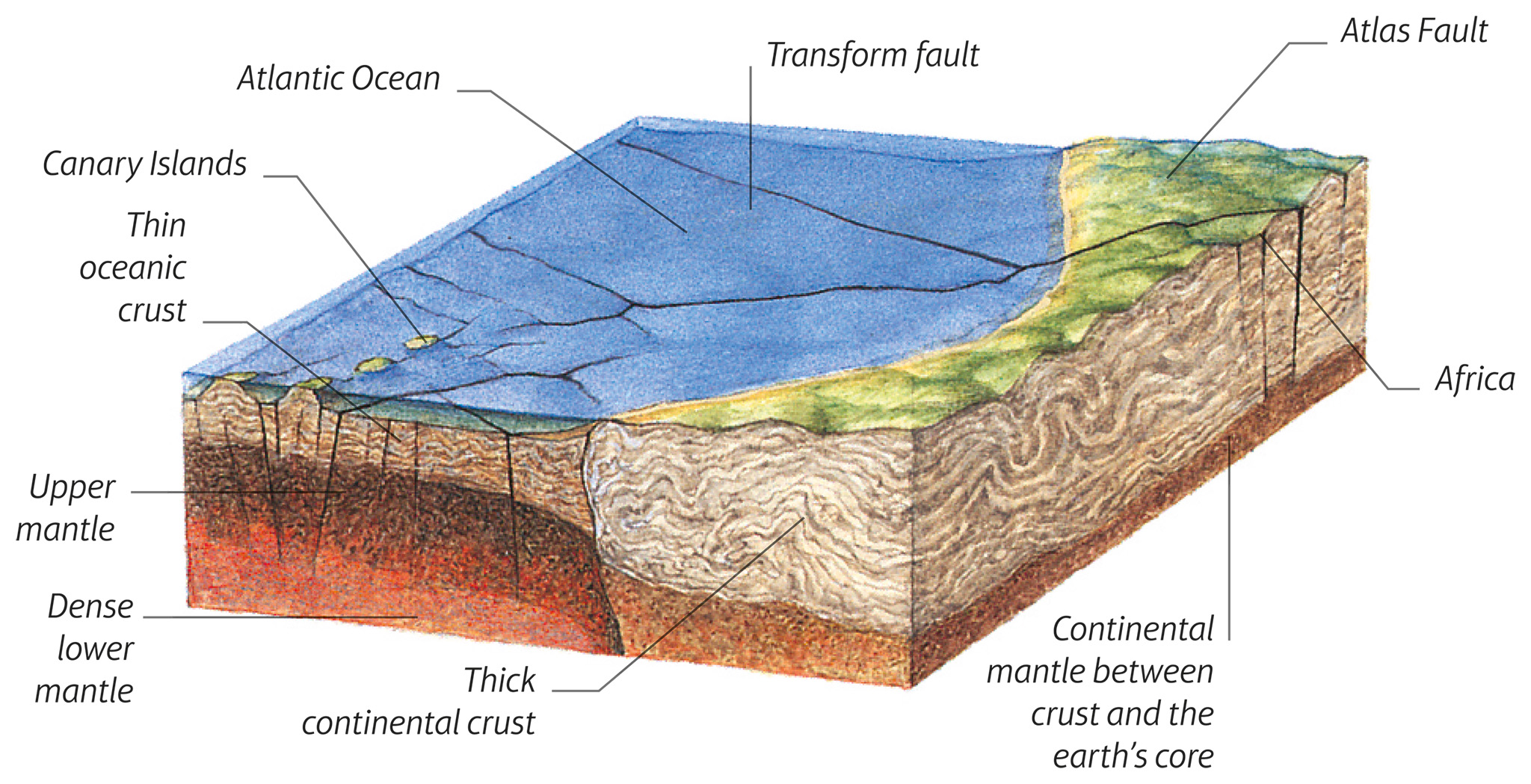
t The fault lines that formed the Canary Islands
The Canaries are situated above faults in the earth’s crust. When magma (molten rock) rises through these cracks, volcanoes are formed. Lanzarote, El Hierro and La Palma are wide, gently sloping shield volcanoes standing on the sea floor. All of them are composed of basalt formed by a hot, dense magma.
In recent years, scientists have worried that La Palma is so volatile that its entire western side may fall into the sea, causing a mega tsunami.
EXPERIENCE Eastern Canary Islands
|
Drink The Tiny Bar If you can get a table at this aptly named Puerto del Carmen bar, you’ll be treated to a great view. ⌂ Avenida de las Playas 51, Puerto del Carmen, Lanzarote ∑ 603 24 49 74 Lounge Bar The music and cocktail menu is very good at this cosy Playa Blanca spot. ⌂ Calle Irlanda, Local 6, Playa Blanca, Lanzarote § 676 52 15 36 |
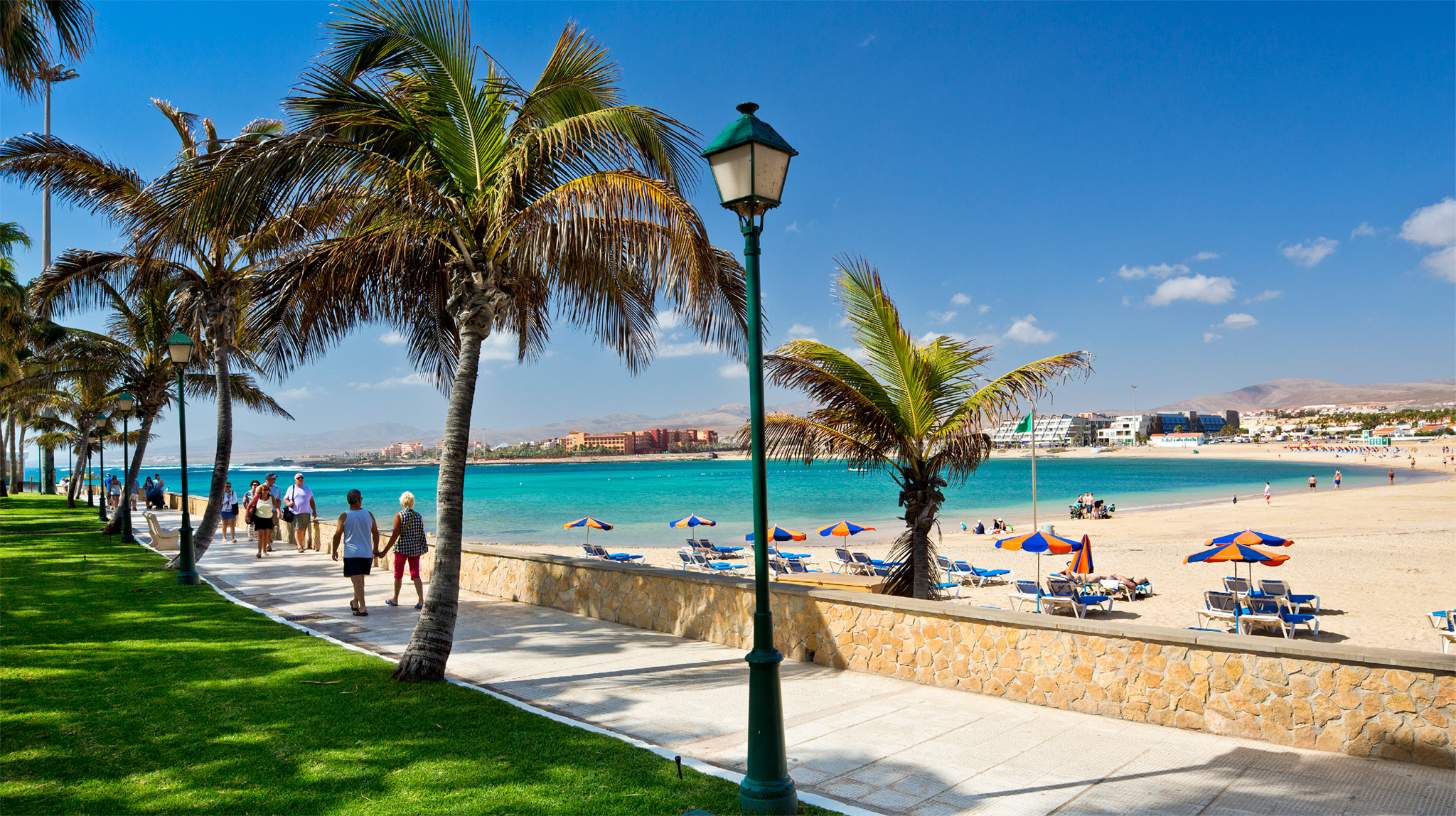
t Playa del Castillo, beside a palm-lined promenade at Caleta de Fuste
About halfway down the eastern coast lies Caleta de Fuste. The attractive low-rise, self-catering holiday centres surround a horseshoe bay of soft, gently shelving sand.
There are many watersports facilities, as well as the Pueblo Majorero, an attractive “village” of shops and restaurants around a central plaza near the beach. These features make Caleta de Fuste one of Fuerteventura’s most relaxed and pleasant resorts.
Fuerteventura’s administrative capital was founded in 1797. Originally known as Puerto de Cabras (Goats’ Harbour), after a nearby gorge that was once used for watering goats, it was rechristened to smarten up its image in 1957. The only large port on Fuerteventura, Puerto del Rosario is the base for inter-island ferries and a busy fishing industry.
Inland, rugged peaks of extinct volcanoes, separated by wide plains, present a scene of austere grandeur. Scattered, stark villages and obsolete windmills occupy the lowlands, which are occasionally fertile enough to nurture a few crops or palm trees. Beyond, devoid of vegetation, the hills form stark outlines. From a distance they appear brown and grey, but up close the rocks glow with an astonishing range of mauves, pinks and ochres. The richness of colour in this interior wilderness is at its most striking at sunset.
Betancuria is built in a lovely valley here, surrounded by mountains. The village was named after Jean de Béthencourt, Fuerteventura’s 15th-century conqueror, who moved his capital inland to thwart pirates. This peaceful oasis is now the island’s prettiest village. The Iglesia de Santa María contains gilded altars, decorated beams and sacred relics. Housed in a traditional Canarian house, the Museo Arqueológico displays many local archaeological artifacts.
To the south, the village of Pájara boasts a 17th-century church with a curiously decorated doorway. Its design of serpents and strange beasts is believed to be of Aztec influence. Inside, the twin aisles both contain statues: one of a radiant Madonna and Child in white and silver, the other a Virgen de los Dolores in black.
La Oliva, to the north, was the site of the Spanish military headquarters until the 19th century. The Casa de los Coroneles (House of the Colonels) is a faded yellow mansion with hundreds of windows and coffered ceilings. The fortified church and the arts centre displaying works of Canary Island artists are also worth a visit.
"
Museo Arqueológico
⌂ Calle Roberto Roldán § 928 85 89 98 # 10am–6pm Tue–Sat

Hidden Gem
Bentan-que
A few kilometres from Betancuria, Castillo de Lara is this delightful picnic spot. There are barbecues you can use (bring your own charcoal) and a kids’ play area.
Excellent beaches of pale sand fringe the Jandía Peninsula in the south of Fuerteventura. A string of urbanizaciones (residential developments) now takes up much of the peninsula’s sheltered east coast (Sotavento).
Costa Calma, a burgeoning cluster of modern complexes, offers the most interesting beaches, with long stretches of fine sand interrupted by low cliffs and coves. Morro Jable, a fishing village now swamped by new developments, lies at the southern end of a vast, glittering strand. Beyond Morro Jable, the access road dwindles away into a potholed track leading towards the lonely lighthouse at Punta de Jandía.
Expanses of deserted sand, accessible only by four-wheel- drive vehicle, line the westerly, windward coast (Barlovento) – too exposed for all but the hardiest beach-lovers. A plethora of subtropical marine life in this area makes it popular with scuba divers.
From 1938 to the early 1960s, Jandía belonged to a German entrepreneur and was out of bounds to locals. Even today, rumours of spies and secret Nazi bases circulate.
This much-expanded fishing village is now one of the island’s two most important resorts. Its main attraction is a belt of sand dunes stretching to the south, resembling the Sahara in places, and protected as a nature reserve – a designation that arrived too late to prevent the construction of two hotels right on the beach.
The rest of the resort, mostly consisting of apartments and hotels, spills out from the town centre. The port area is lively, with busy restaurants and a ferry service to Lanzarote.
Offshore is the tiny Isla de Lobos, named after the once abundant monk seals (lobos marinos). Today, scuba divers, snorkellers, sport fishers and surfers claim the clear waters. Glass-bottomed cruise boats take excursionists to the island.

t The glorious desert-like sand dunes of Corralejo, stretching south from the town, designated a nature reserve
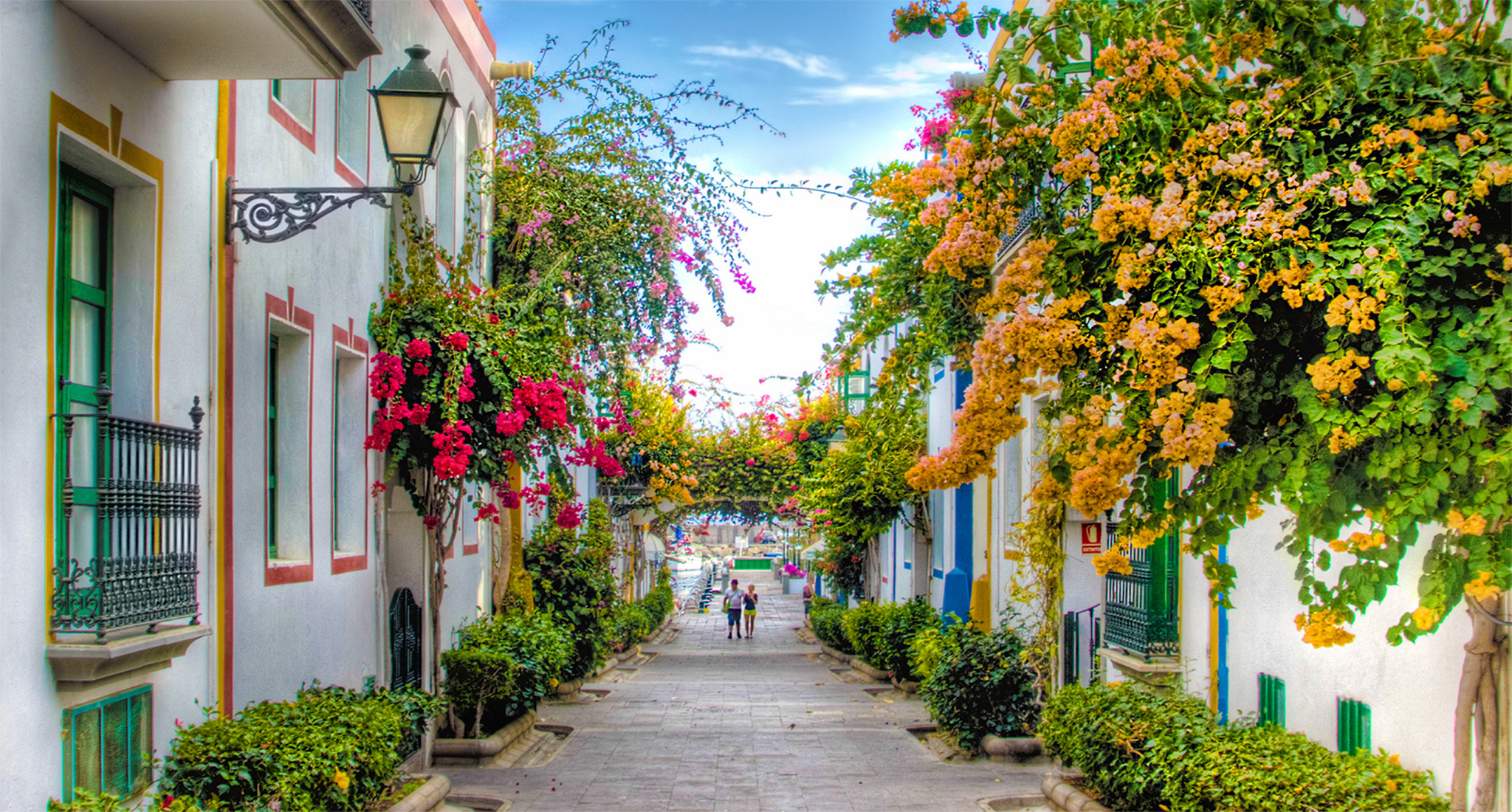
t Bougainvillea-decked houses in Puerto de Mogán’s streets
Situated at the end of the verdant valley of Mogán, this is one of Gran Canaria’s most appealing developments – an idyll to many visitors after the brash Playa del Inglés. Based around a small fishing port, it consists of a village-like complex of pretty, white, creeper-covered houses and a similarly designed hotel built around a marina. Boutiques, bars and restaurants add an ambience without any of the accompanying rowdiness. Development stretches back from the waterfront, but is less intrusive than in other resorts.
The sandy beach, sheltered between the cliffs, is scarcely big enough for all visitors; a car is recommended to reach more facilities at Maspalomas. Ferries provide a leisurely way to get to nearby resorts.
Inland from Puerto Mogán, the road gently climbs through a tropical valley of mangoes, avocados and papaya, to the sleepy white town of Mogán, where terracotta pots litter the roadside. Here, you can sample the rural lifestyle.
Did You Know?
Puerto de Mogán’s canal system has earned it the nickname “Little Venice”.
The barren steep cliffs that stand west of Maspalomas now sprout rows of white apartment complexes at every turn. Puerto Rico is an overdeveloped resort popular with families, but has one of the more attractive beaches on the island, a firm crescent of imported sand supplemented by lidos and excellent watersports facilities. It is a great place to learn sailing, diving and windsurfing, or just to soak up the ultraviolet – Puerto Rico enjoys the best sunshine record in the whole of Spain.

t Rows of sunbeds and umbrellas lined up on the sand at Maspalomas dunes
When the motorway from Las Palmas Airport first tips you into this bewildering mega-resort, it seems like a homogeneous blur, but gradually three separate communities emerge. San Agustín, the furthest east, is sedate compared with the others. It has a series of beaches of dark sand, attractively sheltered by low cliffs and landscaped promenades, and a casino.
The next exit off the coastal highway leads to Playa del Inglés, the largest and liveliest resort, a triangle of land jutting into a huge belt of golden sand. Developed from the end of the 1950s, the area is built up with giant blocks of flats linked by a maze of roads. Many hotels lack sea views, though most have spacious grounds with swimming pools. At night the area pulsates with bright disco lights and flashing neon. There are more than 300 restaurants and over 50 nightclubs.
West of Playa del Inglés the beach undulates into the Dunas de Maspalomas. A pleasant contrast to the hectic surrounding resorts, these dunes form a protected nature reserve. Their western edge (marked by a lighthouse) is occupied by a cluster of luxury hotels. Just behind the dunes lies a golf course encircled by bungalow estates.
Everything is laid on for the package holiday: watersports, excursions, fast food, as well as go-karts and funfairs. One of the most popular attractions is Sioux City, a fun-packed Western-themed park, where you can watch stuntmen perform amazing feats.
"
Sioux City
⌂ Barranco del Águila, San Bartolomé de Tirajana # Summer: 10am–5pm & 8pm–midnight Tue–Sun; winter: 10am–5pm & 6–8pm Tue–Sun ∑ siouxcitypark.es
Rows of sunbeds and umbrellas lined up on the sand at Maspalomas dunes
EXPERIENCE Eastern Canary Islands

Canary Island Fiestas
Carnival
Santa Cruz de Tenerife hosts one of Europe’s biggest carnivals in February or March. Carnival also takes place on Lanzarote and Gran Canaria.
Corpus Christi
In Tenerife, La Orotava’s streets are filled with flowers in striking patterns. The Plaza del Ayuntamiento is covered in copies of works of art that are formed from coloured volcanic sands.
Romería de la Virgen de la Candelaria
Pilgrims visit Candelaria, in Tenerife, in their thousands to venerate the Canary Islands’ patroness on 15 August.
Fiesta del Charco
People leap into a large saltwater pond to catch mullet from 7 to 11 September in San Nicolás de Tolentino, Gran Canaria.
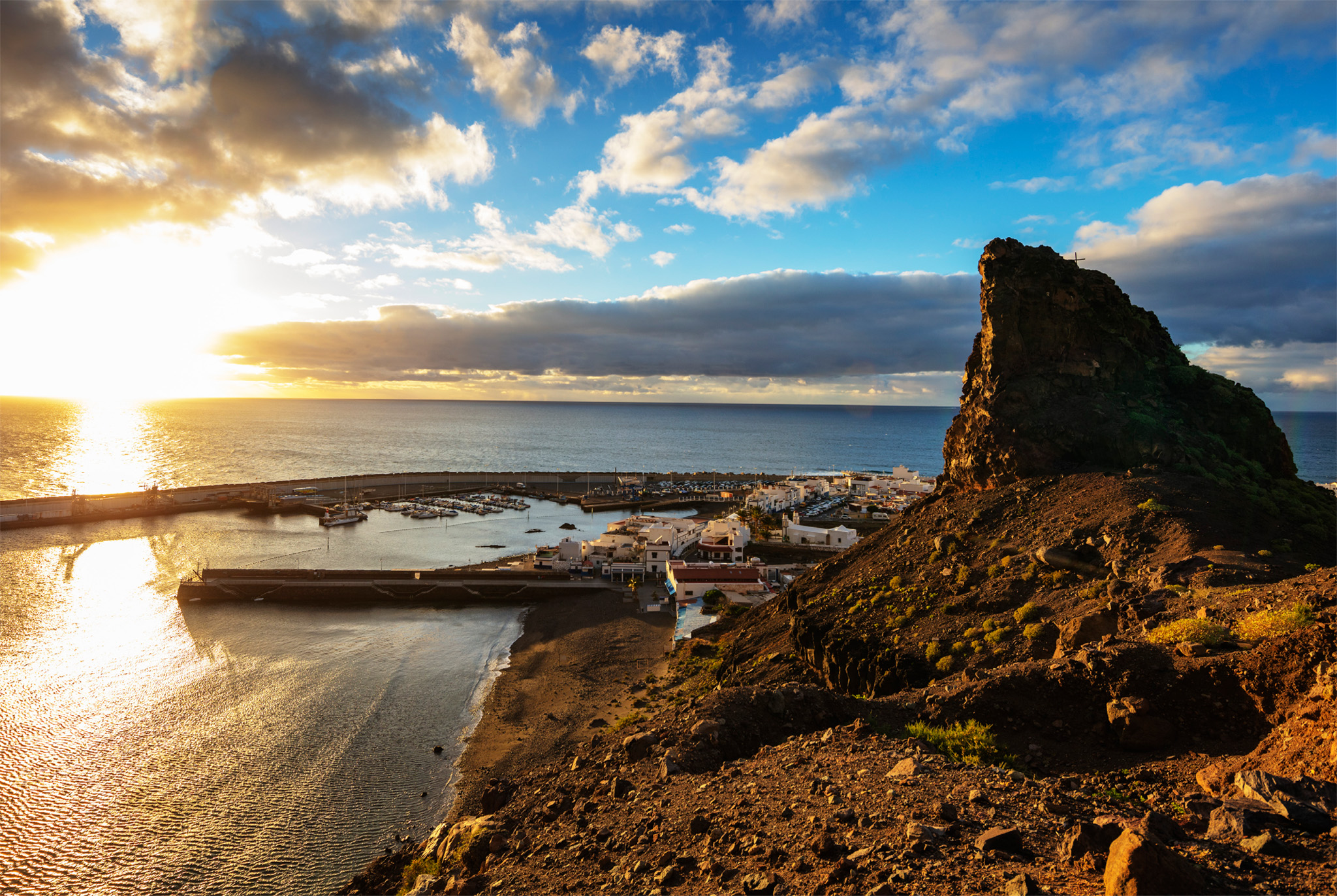
t The rocky shore and steep cliffs of the north-east coast near Agaete
The cloudier northern side of the island is far greener and lusher than the arid south, and banana plantations take up most of the coastal slopes. Agaete, on the northwest coast, a pretty scatter of white houses around a striking rocky bay, is growing into a small resort. Every August, Agaete holds the Fiesta de la Rama, a Guanche rainmaking ritual which dates from long before the arrival of the Spanish. An animated procession of people bearing green branches heads from the hills above the town down to the coast and into the sea. The revelers beat the water to summon the rain.
The Ermita de las Nieves contains a 16th-century Flemish triptych and model sailing ships. Close by is the Huerto de las Flores, a botanical garden.
A brief detour inland up along the Barranco de Agaete takes you through a fertile valley of papaya, mango and citrus trees. North of Agaete are the towns of Guía and Gáldar. Though there is little to see here, both parish churches do contain examples of the religious statuary of the celebrated 18th-century sculptor José Luján Pérez.
Towards the north coast lies the Cenobio de Valerón. This cliff face is pockmarked with nearly 300 caves beneath a basalt arch. These caverns are believed to have been hideaways for Guanche priestesses, communal grain stores and refuges from attack.
" '
Huerto de las Flores
⌂ Calle Huertas § 928 55 43 82 # 10am–4pm Tue–Sat
The Guanches
When Europeans arrived in the Canary Islands in the early 15th century, they found tall, white-skinned people, who lived in caves and later in small settlements on the edges of barren lava fields. Guanche was the name of one group on Tenerife, but it came to be used for all the indigenous people of the islands. The origins of the Guanches are unclear, but it is probable that they arrived on the islands in the 1st or 2nd century BC from Berber North Africa.
The hills southwest of Las Palmas have long been desirable residential locations. A colonial air still wafts around Tafira’s patrician villas. The Jardín Canario, a botanical garden founded in 1952, is the main reason for a visit. Plants from all of the Canary Islands can be studied in their own, re-created habitats.
Near La Atalaya lies one of Gran Canaria’s most impressive natural sights – the Caldera de la Bandama. This is a volcanic crater 1,000 m (3,300 ft) wide, best seen from the Mirador de Bandama, where you gaze down into the green depression about 200 m (660 ft) deep. Some of the inhabited caves in the Barranco de Guayadeque, a valley of red rocks to the south, were dug in the late 15th century.
Jardín Canario
⌂ Carretera de Dragonal, km 7 # 9am–6pm daily ¢ 1 Jan, Good Fri, 25 Dec ∑ jardincanario.org
EXPERIENCE Eastern Canary Islands
|
Stay Gold By Marina This modern adults-only hotel is a short walk from the Playa del Inglés. It has a rooftop terrace with sunbeds, a hot tub and sauna. ⌂ Avenida Estados Unidos de America 15, Playa del Inglés, Gran Canaria ∑ en.goldbymarina.com ¡¡¡ Casa Mozart A charming boutique hotel, which balances its buzzy location in the centre of Las Palmas with a calm atmosphere. ⌂ Calle Mozart 2, Las Palmas, Gran Canaria ∑ casamozart.com ¡¡¡ |

t Casa de Colón, a museum in Las Palmas de Gran Canaria dedicated to Columbus
The largest city in the Canary Islands, Las Palmas is a bustling seaport and industrial city, with 1,000 ships docking here each month. Although the city has faded somewhat from the days when wealthy convalescents flocked here in winter and glamorous liners called in on transatlantic voyages, it remains a vibrant place to visit.
Las Palmas is built around an isthmus. The modern commercial shipping area, Puerto de la Luz, takes up the eastern side of the isthmus, which leads to the former island of La Isleta, a sailors’ and military quarter. On the other side of the isthmus is the crowded Playa de las Canteras, a 3-km- (2-mile-) long stretch of golden beach.
For a scenic tour, begin in the Parque Santa Catalina, near the port. This is a popular, shady square of cafés and newspaper kiosks. In the leafy residential quarter of Ciudad Jardín, you’ll find the Parque Doramas, while in the Pueblo Canario visitors can watch folk dancing and browse in craft shops. At the end of town is the Barrio Vegueta, a charming quarter that dates back to the Spanish conquest. At its heart stands the Catedral de Santa Ana, begun in 1500. The adjacent Museo Diocesano de Arte Sacro contains works of religious art.
Nearby, the Casa de Colón is a 15th-century governor’s residence where Columbus stayed. A museum dedicated to his voyages displays charts, models and diary extracts.
For early history, visit the Museo Canario, which contains Guanche mummies, skulls, pottery and jewellery.
"
Museo Diocesano de Arte Sacro
⌂ Calle Espíritu Santo 20 § 928 31 49 89 # 10am–4:30pm Mon–Sat
"
Casa de Colón
⌂ Calle Colón 1 § 928 31 23 73 # 10am–6pm daily ¢ 1 Jan, 24, 25 & 31 Dec
" '
Museo Canario
⌂ Calle Doctor Verneau 2 # 10am–8pm Mon–Fri, 10am–2pm Sat & Sun ¢ 1 Jan, 25 Dec ∑ elmuseocanario.com

Picture Perfect
Fruit Pastel
San Juan, a barrio of Las Palmas de Gran Canaria, is a pretty collection of multicoloured houses that transforms the hillside into a pastel patchwork, or a game of Tetris brought to life.
